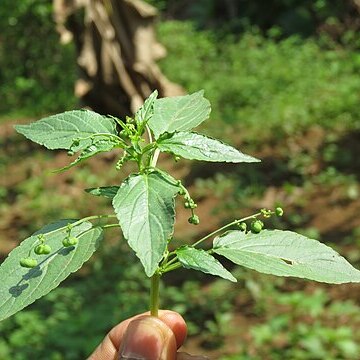Herbs or shrubs, evergreen, annual or perennial, monoecious or dioecious; stems and foliage without latex. Indumentum of simple, multicellular trichomes, glandular trichomes absent, stinging trichomes absent. Stipules entire, inconspicuous, deciduous. Leaves alternate, petiolate, elobate, penninerved, crenate to serrate, glands absent. Inflorescences axillary, racemose or spicate, solitary or fascicled, uni-or bisexual and androgynous, with flowers in bracteate clusters. Male flowers pedicellate; calyx lobes 3 or 4, valvate, free; petals absent; disc of 3 or 4 glands; stamens 3–30, filaments free, biseriate; anthers basifixed, bilobate, thecae obovoid and longitudinally dehiscent; pistillodes absent. Female flowers sessile to pedicellate; calyx lobes 3–5, imbricate, shortly connate; petals absent; disc of 2–6 glands; ovary 2–4-locular, ovules uniloculate; styles 3, free, simple, laciniate. Fruit capsular, trilobate, surface with simple hairs, dehiscing septicidally into 3 bivalved cocci. Seeds subglobose; testa crustaceous; albumen fleshy; caruncles divided, arilloid; cotyledons broad, flat.
Male flowers pedicellate; calyx closed in bud, later splitting into 3(4) valvate lobes; petals absent; disk of 3–30 free interstaminal glands or absent; stamens 3–30, usually biseriate, filaments free, short, anthers extrorse, basifixed, the cells obovoid, free, longitudinally dehiscent; pistillode absent.
Female flowers pedicellate; sepals 3–5, imbricate; petals absent; disk glands 2–6, often resembling staminodes and alternating with the cocci; ovary 2–4-locular, with 1 ovule per loculus; styles 2–4, free, spreading, linear, usually fimbriate or plumose-laciniate.
Seeds subglobose, ecarunculate, thinly arillate; testa crustaceous, often foveolate-reticulate; albumen fleshy; cotyledons suborbicular, sometimes scarcely larger than the radicle.
Fruits 2–4-coccous, or monococcous by abortion, dehiscing septicidally and loculicidally; pericarp thin; endocarp crustaceous; columella persistent, crustaceous or woody.
Leaves alternate (sometimes opposite in lowermost), petiolate, stipulate, stipellate, simple, crenate or serrate, membranous, penninerved, often purplish-tinged.
Inflorescences axillary, spicate or racemose with the flowers in male, female or bisexual bracteate clusters along the axis, usually the terminal flower female.
Dioecious or monoecious annual or perennial herbs or shrubs (or small trees outside the Flora Zambesiaca area).
Indumentum simple.

